Did You Know ?
Circumstances encourage a form of evolution generally thought impossible, says
S.Ananthanarayanan.
Evolution takes place when a small change in an organism confers a survival advantage, and
in time, the evolved population grows apart into a separate species. Masaki Hoso and
colleagues in different institutes in Japan report in the journal, Nature Communications, an
instance of a separate population growing despite a reproductive disadvantage, thanks to the
same feature also keeping predators away.
Handed-ness in snails
The snail is a remarkably evolved creature that carries with it its shell, which is its
habitation and its protection from elements and predators. The snail, in fact, has no bones,
unless we say it has its skeleton on the outside! Many of the snails organs are within the
shell and the whole snail can retract into the shell when desired. For efficiency and
economy, the shell is shaped as a coiled tube - the coil helps keep the dimensions
manageable and grows narrower towards the centre, which gives protection.

But because the shell is coiled, there is the question of which way does the coil go round?
The vast majority of snails have shells that go round clockwise, very few with shells that
go round counter-clockwise. The first kind are called dextral , or right-handed and the
second kind sinistral,or lefthanded.
But this handedness of the snail has a serious consequence, that opposite handed snails
cannot easily reproduce! Right-handed snails, which are the great majority, would thus mate
only with their own kind and the question about left-handed snails, which form effectively a
separate species, is how did they come about and how do they continue to exist?
Speciation
The emergence of a new species happens when portions of a population accumulate genetic
differences to the point that they can only reproduce within themselves. When species
diverge, it usually happens because a population is divided, physically, by a mountain or a
river, so that there can be no ‘gene exchange’ or when populations migrate and evolve
separately. This is the most common way and it is called allopatric speciation. The word
means ‘other fatherland’ and what happens is that there is a ‘habitat fragmentation’. Over
time, they undergo ‘genetic drift’ and become reproductively incompatible.
Another method is by domesticated animal husbandry. While the mechanisms are not clear, in
the case of domestic sheep, they no longer produce viable offspring with some of their
ancestral species. But domestic cattle can be considered the same species as many varieties
of wild ox, gaur, yak, etc., as they are able to effectively breed with them.
The biologist Diane Dodd was able to show that only 8 generations of dietary separation can
create speciation via mating preferences in fruit flies.
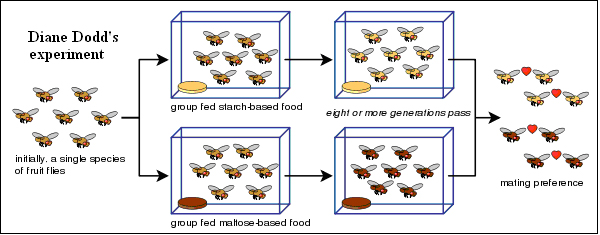
Milder forms of Allopatric speciation are in peripatric and parapatric speciation, where
there is partial separation of populations. But sympatric speciation is when an ancestral
species grows into 2 or more, while still in the same location. While there are instances,
of insect populations that become dependant on different host plants, whether the sympatric
is a separate mechanism or only a form of micro-allopatric speciation, is not decided.
It is in this context that the emergence of the sinistral snail population, within a
predominantly dextral community, presents a paradox.
Genes and evolution
Genetic changes that lead to evolution often come about with changes in only a few genes
that control a large number of features. Handed-ness, which arises in all species, is
controlled by a set of genes called Nodal, which control the multiplication of cells in
different places, to develop as the particular organs. Deficiency in Nodal, for instance,
causes asymmetries and congenital heart defects in about 8 out of 1000 newborns.
Handedness in snails is found to depend on a single maternal gene in at least 4 kinds of
common snails, which have lungs. Genetically engineering snails to select for this gene
could thus generate a separate dextral and sinistral snail populations. Such left to right
reversal, in fact has been observed to arise frequently and repeatedly among land snails,
and not by genetic manipulation. The question is how can such a mutation, when it occurs, be
sustained, when the reverse handedness is a direct reproductive handicap.
Predator specialisation
What Masaki Hoso and colleagues have discovered is that the reverse handedness, in fact,
confers such a survival advantage, willy-nilly, that it compensates for the mating
disadvantage. The advantage comes about because of the specialized evolution of South East
Asian snakes, to prey more conveniently on right-handed snails!
The pareas Iwasakii is a common, snail eating snake in Japan. As the reptile specializes in
hunting snails, it has evolved apparatus adapted to holding the shell and accessing the
succulent contents. Thanks to the great majority of snails being dextral, the whole family
of pareatidae, or snail and slug eating snakes, has evolved remarkable asymmetry in the
number of teeth in the jaw bone, to enable gripping of the right-spiralling snail shell But
thanks to this specialization, the evolved snakes can rarely get a grip on a sinistral
snail!
The hypothesis of Masaki Hoso and others was hence that left-handed snails should hence
emerge more frequently in environment which had the snakes, as compared to other areas.
Anther thing – the emergence of sinistral lines should be more common with flat or larger
snails than with taller snail species. The reason is that it is virtually impossible for
flat snails of opposite handedness to mate, while it is still possible with tall snails
which mate by ‘shell mounting’. And again, it the larger shell that presents the greater
difficulty for gripping, if it is sinister, for the snake. Hence, the larger sinister snails
would have a greater survival advantage.
The scientists carried out a worldwide analysis of populations of dextral and sinistral
snails and pareatid snakes. The study clearly shows that a single gene, which causes
reproductive incompatibility, could generate a new species, given natural selection by
ecological factors
[the writer can be contacted at simplescience@gmail.com]
Situs inversus
Just like with the sinistral snail, congenital inversion of the major organs can occur in
humans. The human body is externally symmetrical – we have 2 eyes, 2 ears, 2 arms and legs,
each side of the body looks the same. But our major organs are not duplicated – the stomach
and spleen are on the left side of the abdomen and the liver and gall bladder are on the
right. The internal structure of the brain and heart is not the same on both sides and the
heart is located to the left, within the thorax.
A rare genetic peculiarity is when all the organs are on the opposite side. This condition
is called situs inversus and is seen less than once in 10,000 births. The positions of the
organs are reversed, even the heart is on the right, except in exceedingly rare cases, where
the heart alone is in the correct position. We can see that for transplant, a situs inversus
recipient will need a similar donor!
Celebrities who were situs inversus include Randy Foye, American basketball player and
Catherine O’Hara, Canadian comedy actress. Dr No in Ian Flemmings’s James bond novel was
also situs inversus and he survived an attempt of murder because the assassin who was
aiming for the heart stabbed in the wrong side!
|
DOWNLOAD FREE!
The Marine Biology Regional Centre, Zoological Survey of India, Chennai has prepared beautiful and informative posters on the rich marine resources of India.
You can access them at http://marineresources.wildbytes.in/#!home
The posters are on various subjects

http://marineresources.wildbytes.in/#!home
To see the slide show, please click on the right hand corner of the main poster.
To download a high resolution poster for print, please click on the down arrow just above the poster.
The posters have been made available to members of Indianwildlifeclub.com courtesy Dr. K. Venkataraman, Additional director, Marine Biology Regional Centre, Chennai.
|
Endangered
-Vinod Rishi
Here is the second part of an article published by Shri Vinod Rishi in
The paradigm shift in the approach for monitoring tigers – NTCA’s holistic approach
In a Technical Note the newly constituted National Tiger Conservation Authority (NTCA) made a mention of the criticism faced by the pugmark based census methodology and the limitations, both in design and application, of the alternative proposal to estimate
tiger densities from individually identified tigers using camera traps as the reason for adopting their new approach.
In this approach NTCA applied a hierarchical model and statistical framework for monitoring tigers and other animals. The entire tiger range in India was converted to 6 Landscape Complexes covering 17 Tiger States; each Landscape Complex used Forest Beats or
equivalent areas covering 15-20 sq km of wildlife habitat as the smallest sampling units. Habitat occupancy by tigers was surveyed in all units, and the units were categorized in terms of tiger sign abundance classes – high, medium, low and no density class
– at Forest Beat sampling unit level and at 100 km2 area resolution level. Population densities for tigers were estimated in 5 – 13 replicates of the size of 100-200 km2 in each of the tiger sign abundance classes in which the Landscape Complex had been stratified.
Mark-Recapture sampling method was used to find out tiger densities. Extrapolation of densities was carried out from the results obtained in each sub-sample level to the area covered by its corresponding tiger sign abundance class at landscape level. It was
then followed by conversion of densities/indices into numbers. Computer programs specially designed for the purpose were used for the analysis of the data. A large manpower of trained researchers supervised the collection of field data, which was then verified
by international and national experts (Jhala, Y.V., et al., 2005a, 2005b, 2008).
The results obtained by paradigm shift
The results of the holistic approach were declared in 2008. The estimated all India tiger population is reported to be between 1,165 and 1,657, with a mid value of 1,411 tigers in India. For public consumption the mid value is reported as the population of
tigers in India. It is the latest report on the status of India’s tigers. (Jhala, Y.V., et al., 2008).
Reliability of results from current approach for monitoring and conservation of tigers
A. National Level Monitoring:
The scope for use of the results in monitoring and conservation of tigers has been reduced by the following factors:
1) The figure of 1,411 tigers is the arithmetical mid-value of a statistical range, and not the actual number of tigers. The statistical estimate with a minimum value of 1,165 and a maximum of 1,657 spans a margin of 492 numbers, which is almost 40% of the
minimum value. Somewhere within this margin lies the actual population of tigers in India. With almost 500 numbers to choose from the estimate, a large population falls in the indeterminate grey area. The lack of reasonable precision in the result makes the
reported status of tigers in India too vague to be of any utility in the monitoring and conservation of tigers.
2) The extended period of time over which the field data was collected in 2005-2006 does not permit one to define a temporal reference point for comparison with later date estimates. Small populations of tigers can disappear in an extended time frame. There
was no fixed date(s) common to all places from where the data was collected. Because of the absence of any common temporal reference point, the data does not lend itself for comparison with any other data for monitoring the status of tigers in India.
3) The results do not give the structure of tiger populations: the work has not provided any information on the age, sex and breeding status of the tigers; and the methodology is not designed to provide information on juveniles, cubs and transient tigers.
4) Even with field data collected under the supervision of a large and highly qualified manpower, and its verification carried out by national and international experts (Jhala et al., 2008), serious flaws have appeared in the tiger occupancy estimates. The
methodology could not generate reliable tiger habitat occupancy maps and other related records.
a. For instance, the map for northern West Bengal shows tiger occupancy in Gorumara National Park, and in fragments of Buxa tiger reserve and other forest areas that have had no record of resident tigers over the past more than five years; also, the map
shows absence of tigers in tiger occupied areas like Mahananda Wildlife Sanctuary and the northern part of Buxa tiger reserve where one was recently photographed.
b. The sampling based statistical estimation of the extent of area under tiger occupation is erroneous for Sunderbans and many other tiger habitats. Therefore, the extrapolation of densities calculated from such erroneous base-line data cannot give accurate
information.
-to be continued
|
Events
Ecoscope 2011: Nature & Wildlife Photography Exhibition
Mihir Chhatre invites you
Time Wednesday, January 12 at 10:00am - January 16 at 8:00pm
Location Yashwantrao Chavan Natyagriha (Kaladalan), Kothrud, Pune, India
Entering its ninth year, Ecoscope was conceived as a platform for budding and amateur wildlife photographers who have managed to capture the vast natural beauty and diversity of our country. Every year, this showcases some of the rarest and most fascinating
glimpses of the wild.
Ecoscope 2011 would comprise of almost 180 photographs taken by 40 photographers covering the entire expanse of India – from the enigmatic cold desert o...f Ladakh and awe inspiring Himalayas to the exotic lands of Arunachal Pradesh and from the dense forests
of the north-east to the dry regions of Kutch. It would also include photographs from almost all the leading wildlife reserves & tiger habitats like Kanha, Corbett, Bandhavgarh, Ranthambhore, Nagarahole and Tadoba.
The exhibition would also host a contest for all the visitors – the “Evergreen Eco-caption Competition”. In this competition, participants are expected to create their own slogans based on the theme of nature. The contest will be held in two age groups – one
would be above 15 years & other would be below 15 years of age. There would be a winner each from both the categories who would receive a prize from Foliage Outdoors.
Green Guides Programme @ CEC
(8-9 January and 15-16 January 2011)
The year 2010 has been declared as Biodiversity Year by United Nations. To
develop a volunteer force of dedicated individuals for nature conservation,
the
Conservation Education Centre (CEC) of BNHS is has announced `Green Guides
Programmes' (earlier known as Volunteer Training Programme (VTP). Since 2004
we have been successfully conducting the VTP at CEC and trained more than
200 volunteers so far. We are proud to say that the "Save Rani Baugh"
committee members are our alumni. This programme is suitable for all those
who wish to work in the field of conservation education by contributing
their time and knowledge.
The residential training programme is divided into two modules. These
modules include subjects like natural history, environment education and
nature
conservation. Please note attending both the modules is important for
successful completion of the training programme. At the end of training
programme,
participation certificates will be awarded to all the participants. After
attending the training programme, participants would get opportunities to
get hands on training experience at CEC during the `Shadowing Phase' and
then will be absorbed as regular volunteer. Let's come & be a part of an
ever-growing
tribe of Green Guides.
Dates: Module-I: 8-9 January, Module-II: 15-16 January 2011 Time: 9.00 a.m.
(First Day) to 04.00 p.m. (second day Last Date of Registration: 5th January
2011.
REGISTRATION DETAILS
Venue: BNHS Conservation Education Center, Near Film City, Goregaon
(East),Mumbai- 400065. For directions on how to reach, please visit our
website:http://cecbnhs.wetpaint.com/
For Registration: Download registration forms from www.bnhs.org or
http://cecbnhs.wetpaint.com/ and send the dully filled form along with the
cheque by Vichare couriers to the Goregaon or Fort Office. You could also
request us to send you a form by writing to us at
cecbnhs@gmail.com
For Queries contact the education staff: Ms. Priti Choghale or Mr Sachin
Chorge, on 9594929107, 9594953425, 9223513425 (Monday-Friday between 10.00
a.m. to 5.00 p.m.).
<http://www.bnhs.org>
Conservation Education Centre*
Near Filmcity, Filmcity road, Goregaon (E), Mumbai - 400065,Maharashtra,
India.
*Tel:91-22- 28402931; Mobile: 9594929107/ 9594953425 / 9323738622
Visit us:* <http://cecbnhs.wetpaint.com/>
Help The Birds-2011.
During Kite-flying festival, (14th-15th January) thousands of birds fall victim to the sharp
glass powder coated maanja with injuries on their wings or just about anywhere, bleeding
them to death. This festival is one of the most unfortunate manmade disasters for the avian
community of our city. More than 2000 birds get 'cut' every year in Ahmedabad (India) alone.
The kite strings are so sharp that it sometimes chop off the whole wing!! The festival is
round the corner and we need to prepare ourselves to save as many lives as we can.
HTB 2011 is coming up. HTB (Help the Birds) campaign is organized every year in Ahmedabad by
many N.G.O. with join hand with forest department, Wildlife Rescue Center during the
Kite-flying festival (Uttarayan) as an effort to save the injured birds from certain death
and giving them a survival chance. Our primary focus will be birds of endangered species,
especially White-Rumped Vultures. Who will want to save these precious birds and YOU can be
one of them. We need your involvement to make this campaign a success! There are several
ways in which you CAN help, even if you are not comfortable with working hands on with
injured birds. Apart from rescue, we will need volunteers for attending rescue phone calls,
documentation, education / awareness programs, helping vets in the operation theater,
transfer of birds, transportation of injured birds, data collection, donation and much more…
All of this work is extremely important for the campaign. This is your chance to help the
urban bird life. Every one of us can make a big difference in saving lives of the innocent
feathered friends. Let us all join hands and try to help them in whichever way we can. We
want veterinary doctors.
Kartik Shastri,
JIvdaya charitable Trust,
Advisory committee Member
Bird conservation society Gujarat-vulture cell
Assistant coordinator,
Ahmedabad,
Gujarat,
India.
Mo: 098240-25045.
E:mail:kartikgyps@gmail.com
kartikshastri@hotmail.com
Wildlife Photography – advanced workshop
Caesar Sengupta invites you
Sunday, January 16, 2011 · 12:30am - 3:30am
Location Hotel Sharanam
Eastern Express Highway Service Road, Near New R.T.O.
Thane West - 400604
More Info Registration enquiries: Call 9819839821 / 09920772965
Session 1: Post Processing – Tips and tricks: 9 am – 1 pm
Session 2: Post Processing – Practicals : 1 pm – 4 pm
Note:
Basic necessities – your interest to learn photography
Additional requirements – Carry along your best photographs
Better if - you carry your laptop if you have one
Duration – full day – 9 am – 4 pm with breakfast, lunch and tea
India for Animals, Conference
Sowmya Reddy invites you
Saturday, January 29, 2011 at 9:00am - Monday, January 31, 2011 at 10:00pm
Location The C.P. Ramaswami Aiyar Foundation
1, Eldams Road, Alwarpet, Chennai - 600 018.
Chennai, India
More Info FIAPO is holding the first India for Animals conference from on January
29th, 30th, and 31st, 2011, in Chennai, India, in broad terms, to introduce people to new
ideas in animal protection; to help them improve their abilities, as organisations and as
individuals, to take positive action for animals; to inspire and energize their work; to
provide a platform within which to feel a sense of fellowship with other animal protectors
and overcome the isolation that we sometimes feel in our work; and to push Indian animal
activists forward in all our ability to strengthen the animal protection movement in the
country.
Learn about how to register online at:
http://indiananimalsfederation.org/index.php/registration.html
|
Gardening for wildlife
-Contd from last month
The Butterfly Diaries
The white-eared bulbuls (Pycnonotus leucotis) who wake me are not the bulbuls one meets
elsewhere in India but are of the white-cheeked variety but without the pointed crests that
their cousins from the hills sport. Earlier considered a subspecies, I am told they have
been promoted to the rank of a separate species.
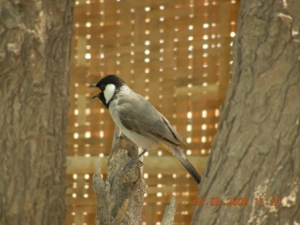
The handsome desert bulbul!
They fly around, peck at things, warble in the bushes, or on the fence and provide a running
commentary on all that's happening throughout the day. They, along with the squirrels and
jirds are my constant companions and I love them dearly. Indeed, one pair did try to nest in
the thatch fence but they abandoned the attempt due to a unseasonal heatwave. I pamper them
with choicest grains and by shooing away the 'Bharadwaj' (Greater Coucal) bird when he calls
upon me. They reward me with their melodious calls and assume coquettish postures for my
amusement.
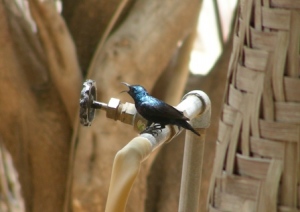
The feisty little purple sunbird.
The other residents of my garden include sunbirds, sparrows, doves and crows. The sparrows
nest in the eaves, the doves in the storehouse rafters, the crows somewhere in the ad hoc
repairs of the roof in my backyard and the sunbirds I know not where.

Mrs Sparrow comes to call on!
It is during the hot hours of the day when I find my most interesting guests. Sometimes it
is a Roller perched on a branch under the tree enjoying the coolness just under the canopy
where the loo cannot reach directly. On other occasions its a White-browed Fantail, about
whom I am constantly admonished by birdwatchers not to refer as a flycatcher any more. Let
him catch the two-winged insects, but he must NOT be named as such, declares one soul who
fixes me with a glare as if I had just used the much-abhorred 'n_' word in a congregation of
politically correct citizens.
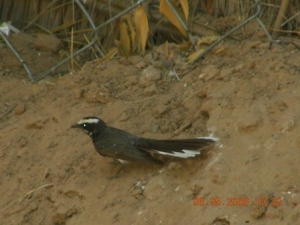
Remember, a fantail, not a flycatcher! Oh forget it, lets just call it Rhipidura aureola
During the hot hours of the garden, the creatures are to be found in the shadiest, coolest
places. Some, for no conceivable reason why, try other methods. The squirrel who lives in my
garden is one such. At this time the birds cling to the shade but off the ground, the jirds
are deep underground while Wally the squirrel, so named because he scarfed walnut kernels
from her one day, insists on remaining on the sandy floor in the dappled shade below the
tree. So to remain in that spot, he resorts to all kinds of tricks. Sometimes, he is on his
belly with four hot feet off the ground. Sometimes he grasps the tree trunk while standing
on his hind-feet. Intent on his cooling tricks, he fails to notice the bucket of water I
send halfway across the garden. Suddenly sodden, he is shocked for an instant before taking
off up the tree but I do hope I have helped him remain cool.
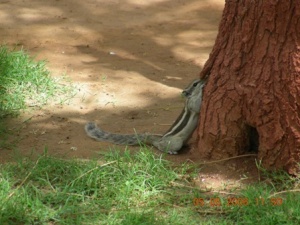
"Maybe hugging the tree is a better idea.
|
Members Speak
-Jayant Deshpande
Come spring and the alarm of the electronic clock used to be redundant. As soon as the day
broke the Indian plaintive cuckoo would start singing. The rising notes of this bird would
be immediately challenged by the Common Hawk Cuckoo. Pied Crested Cuckoo would add its calls
eager not to be left behind. This Cukoo cacophony would be pierced by the clear singing
notes of our common Koel.
However as I would try it was impossible to sleep with the windows open or closed. Thus the
birds forced me to welcome another day and get ready for work. As I had my morning tea I
would be aware of all the other small birds like the Sunbirds, Ioras, Bulbuls, Flycatchers
and White Eye. The Shikra and the Sparrow hawk would make their royal presence felt on some
days, causing flutter amongst the smaller and weaker subjects. From these feathered friends
I drew energy to beat the Monday blues, and get ready for week long toil.
One evening while coming home, I found a pair of white necked storks was making a nest on
the roadside banyan tree. These birds are foolish, I thought; to make a nest in the middle
of the hustle and bustle of traffic, they would never succeed in rearing their brood. Time
proved me wrong as these birds raised their broods successfully for many years to come. I
would often see them flying past my house towards the river in their quest to get food for
their young ones. As they flew past, my conscience jeered at me telling me that the birds
were wise to choose their nesting site in an urban world.
Pune Municipal Corporation then decided to widen the roads. Development work started around
me as if there was no tomorrow. Trees made way for roads, buildings and compounds. I
curiously watched the development around the banyan tree, which must be at least 60-70 years
old if not more. The canal behind the tree was filled up to make a tar road, cutely named as
a service road, the road in front was made into concrete. To my dismay the branches began to
be lopped. I was the lone mute spectator, in a hopeless minority to this development which
the majority wanted – cost of democracy I thought, and consoled myself. Thankfully the tree
got away with parting a majority of its branches, and has lost the company of the storks for
ever. Now it stands like a helpless battle bruised wounded soldier surveying the destruction
around in the battlefield.
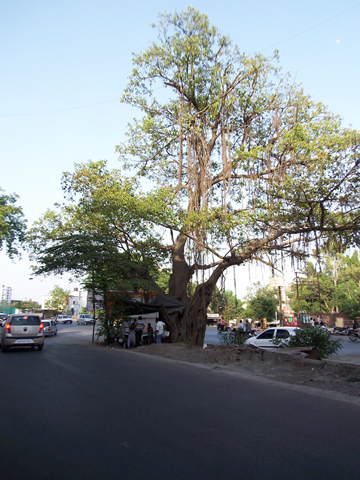
In my house now the windows are closed to make way for the AC. On the bed side table the
mobile rings an alarm to wake me up. The cuckoo cacophony is trapped in an mp3 on my laptop
which is the only memory of the musicians of the yesteryears around me.
|
Web Page
|